Homework of Cryptography
Tony Zhu
December 20, 2010
1 Classical Cryptography
1.21
(c) Affine Cipher
Solution: Since in the affine cryptosystem only φ(26) × 26 = 312 cases for key
K = (a, b), list all the cases brutally with the help of computer and scan quickly, I
found only one case seems meaningful:
ocanadaterredenosaieuxtonfrontestceintdefleuronsglorieuxcartonbrassaitporterlepeeils
aitporterlacroixtonhistoireestuneepopeedesplusbrillan tsexploitsettavaleurdefoitrem-
peeprotegeranosfoyersetnosdroits
After breaking the long sentence, I found it should be the French version of
Canada national anthem:
O Canada
Terre de nos a¨ıeux
Ton front est ceint de fleurons glorieux!
Car ton bras sait porter l’´ep´ee
Il sait porter la croix!
Ton histoire est une ´epop´ee
Des plus brillants exploits
Et ta valeur, de foi tremp´ee
Prot´egera nos foyers et nos droits
1.22
1
�
Proof. (a) Obviously in the case p1 ≥ p2 ≥ 0, q1 ≥ q2 ≥ 0, the sum p1q1 + p2q2
is maximized.
i < q
j,
permute the positions of the two numbers and, according to the statement of last
i > S , contradicts. So the only
i is maximized, and if there exists i > j such that q
Suppose S =n
paragraph, we get S =
i=1 piq
+ p jq
+ piq
j
arrangement for S is q
phq
1 ≥ . . . ≥ q
n.
0≤h≤n
hi, j
h
v
2 Shannon’s Theory
2.2
Proof. P = C = K = {1, . . . , n}. ∀x ∈ P, ∀y ∈ C
Pr[Y = y] =
so
Pr[K = k]Pr[x = dk(y)] = 1/n
k∈K
Pr[x|y] =
Pr[x]Pr[y|x]
Pr[y]
Pr[x] 1
n
=
1
n
= Pr[x]
that is this Latin Square Cryptosystem achieves perfect secrecy provided that ev-
v
ery key is used with equal probability.
2.3
Proof. Similarly as (2.2).
2.5
v
Proof. According to Theorem 2.4, this cryptosystem provides perfect secrecy iff
every key is used with equal probability 1/|K |, and for every x ∈ P and y ∈ C ,
there is unique key k ∈ K , such that y = ek(x).
2
�
Due to perfect secrecy, we have
Pr[x|y] = Pr[x]
= Pr[x]
Pr[x]Pr[y|x]
Pr[y]
Pr[y] = Pr[y|x] = Prek(x)=y[K = k] = 1/|K |.
=⇒
=⇒
that is every ciphertext is equally probable.
v
2.11
Proof. (Perfect secrecy ⇒ H(P|C)=H(P)).
H(P|C) = −
= −
y∈C
x∈P
x∈P
y∈C
= H(P)
Pr[y]
y∈C
Pr[y]Pr[x|y] log2 Pr[x|y]
Pr[y]Pr[x] log2 Pr[x]
= H(P).
(H(P|C) = H(P) ⇒ Perfect secrecy).
According to Theorem 2.7,
H(P, C) ≤ H(P) + H(C)
with equality iff P and C are independent random variables.
so
H(P|C) = H(P)
=⇒ H(P, C) = H(P) + H(C)
=⇒ P and C are independent random variables
=⇒ ∀x ∈ P, ∀y ∈ C, Pr[x|y] = Pr[x],
that is the cryptosystem achieves perfect secrecy.
v
2.12
3
�
Proof. We have
H(K, P, C) = H(P|K, C) + H(K, C) = H(K, C),
so
2.13
H(K, P, C) ≥ H(P, C)
=⇒ H(K, C) ≥ H(P, C)
=⇒ H(K|C) = H(K, C) − H(C) ≥ H(P, C) − H(C) = H(P|C).
v
+ 1
3 log2 3 + 1
6 log2 6 ≈ 1.45915.
Solution: H(P) = 1
2
H(K) = log2 3 ≈ 1.58496.
Pr[1] = 2/9
Pr[2] = 5/18
Pr[3] = 1/3
Pr[4] = 1/6
H(C) ≈ 1.95469.
H(K|C) = H(K) + H(P) − H(C) ≈ 1.08942.
Pr[K2|1] = 0
Pr[K1|1] = 3/4
Pr[K1|2] = 2/5
Pr[K2|2] = 3/5
Pr[K2|3] = 1/3
Pr[K1|3] = 1/6
Pr[K1|4] = 0
Pr[K2|4] = 1/3
H(P|C) ≈ 1.08942.
2.14
Pr[K3|1] = 1/4
Pr[K3|2] = 0
Pr[K3|3] = 1/2
Pr[K3|4] = 2/3
Solution: H(K) = log2 216, H(P) = log2 26, H(C) = log2 26,
H(K|C) = H(K) + H(P) − H(C) = log2 216 ≈ 7.75489.
It is easy to evaluate:
H(K|P, C) = log2 12 ≈ 3.58496.
4
�
2.19
Proof. A key in the product cipher S1×S2 has the form (s1, s2), where s1, s2 ∈ Z26,
e(s1, s2)(x) = x + (s1 + s2).
But this is precisely the definition of a key in the Shift Cipher. Further, the proba-
bility of a key in S1 × S2 equals
26 , which is also the probability
of a key in the Shift Cipher. Thus S1 × S2 is the Shift Cipher.
v
26 pi = 1
1
26
= 1
25
i=0
25
i=0
2.20
Proof. (a) Similarly as (2.19).
(b) The number of keys in S3 equals 26lcm(m1, m2). Form the following fact we
can see that the keys in S1 × S2 are lesser when m1 0 (mod m2).
Notice
m2 < m1, m1 0
=⇒ m1 + m2 < 2m1 ≤
(mod m2)
m2
gcd(m1, m2)
m2 = l, where l lcm(m1, m2)
the equation below, which essentially gives the representation of the keys of prod-
uct cryptosystem S1×S2, would’t always has a solution (K1, K2) = (x1, . . . , xm1, y1, . . . , ym2) ∈
K1 × K2, for any selected key K = (z1, . . . , zl) ∈ K3,
Im1
...
Im1
Im2
Im2
...
Im2
Im2
x1
...
xm1
y1
...
ym2
,
z1
...
...
zl
=
because the coefficient matrix’s column number is less than the row number. Con-
clusively, there must exist key K ∈ K3 that not in K1 × K2.
v
3 The RSA Cryptosystem and Factoring Integers
5.2
5
�
Proof. (a) ri = qi+1ri+1 + ri+2 ≥ ri+1 + ri+2 ≥ 2ri+2.
(b) (c) From (a), m ≤ log2 a + 1 ∼ log a ∼ log b.
5.3
Solution: (a) 17−1 ≡ 6 (mod 101).
(b) 357−1 ≡ 1075 (mod 1234).
(c) 3125−1 ≡ 1844 (mod 9987).
5.4
Solution: 8 × 93 − 13 × 57 = 3.
v
5.5
Solution: It’s easy to see that
−1(x, y, z) = 70x + 21y + 15z
χ
(mod 105).
−1(2, 2, 3) = 17.
χ
So
5.6
Solution: Similarly we have
−1(x, y, z) = (13×26×27)x +(252×27)y +(14×25×26)z
χ
So
−1(12, 9, 23) = 470687.
χ
(mod 25×26×27).
5.7
Solution: Similarly we have
−1(x, y) = (50 × 101)x + (51 × 99)y
χ
13−1 ≡ 61 (mod 99), 15−1 ≡ 27 (mod 101). So
(mod 99 × 101).
(mod 99)
(mod 101)
(mod 99)
(mod 101)
15x ≡ 56
13x ≡ 4
x ≡ 46
x ≡ 98
⇐⇒
=⇒ x = 7471.
6
�
5.9
Proof.
5.11
α ±1
(mod p), α is primitive element modulo p
⇐⇒ the order of α ∈ Z∗
⇐⇒ α ±1
(mod p), αq ≡ −1
p is 2q.
(mod p).
(Because the order of α could only be 2, q or 2q.)
v
Proof. By showing xλ(n) = 1 (mod n), ∀x ∈ Zn, we can prove the encryption and
decryption are still inverse operations in this modified cryptosystem.
Since we have
Zn Zp ⊕ Zq,
and the isomorphism is Ψ(h) = (h (mod p), h (mod q)), it only needs to showxλ(n) =
1 (mod p), and xλ(n) = 1 (mod q).
xλ(n) ≡ (xp−1)
q−1
gcd(p−1,q−1)
q−1
gcd(p−1,q−1)
(mod p).
≡ (1)
≡ 1
(mod p)
(mod p)
For q is the same. So complete the proof.
Solution: (b) p = 37, q = 79, b = 7.
Modified cryptosystem. λ(n) = 468, a = 67.
Original cryptosystem. φ(n) = 2808, a = 2407.
5.13
Proof. (a) Again use the isomorphism
Zn Zp ⊕ Zq,
→
and note that xp−1 ≡ 1 (mod p) and xq−1 ≡ 1 (mod q) for all x 0, we get
Zn
(mod q)) → Mpqxp + Mqpxq
(mod q))
Zp ⊕ Zq
(mod p), yd
(mod p), ydq
Zn
(mod n) → (yd
= (ydp
= (xp, xq)
→
yd
7
v
(mod n)
�
so complete the proof.
(b) p = 1511, q = 2003, and d = 1234577.
After some calculation, we get dp = 907, dq = 1345, Mp = 777, and Mq =
973.
(c) y = 152702, ydp = 242 (mod 1511), ydq = 1087 (mod 2003), yd =
v
1443247 (mod n = 3026533).
5.14
Solution: If gcd(y, n) 1, we get a factor p = gcd(y, n) of n, and another factor
q =
, consequently, dK and x = dK(y) can be calculated explicitly.
n
gcd(y, n)
Now suppose gcd(y, n) = 1, computer ˆy = y−1 (mod n), which is chosen as
the attack allows to know the plaintext ˆx, it is easy to see that x = ˆx−1 (mod n).
5.18
Proof. The isomorphism
is used again to show
Zn Zp ⊕ Zq
eK(x) = xa = x ⇐⇒ (xa mod p, xa mod q) = (x mod p, x mod q).
And
deduce that
p is multiplicative cyclic group of order p − 1,
F∗
q is multiplicative cyclic group of order q − 1,
F∗
#S p = #{x ∈ F∗
#S q = #{x ∈ F∗
p|xa = x} = gcd(a − 1, p − 1),
q|xa = x} = gcd(a − 1, q − 1),
so
#S = #{x ∈ Zn|x 0, (xa mod p, xa mod q) = (x mod p, x mod q)}
= #(S p × S q)
= gcd(a − 1, p − 1) × gcd(a − 1, q − 1)
= gcd(b − 1, p − 1) × gcd(b − 1, q − 1),
the last equation can be easily seen from the equality
ab ≡ 1
(mod (p − 1)(q − 1)), i.e. (a − 1)b ≡ −(b − 1)
(mod (p − 1)(q − 1)).
8
�
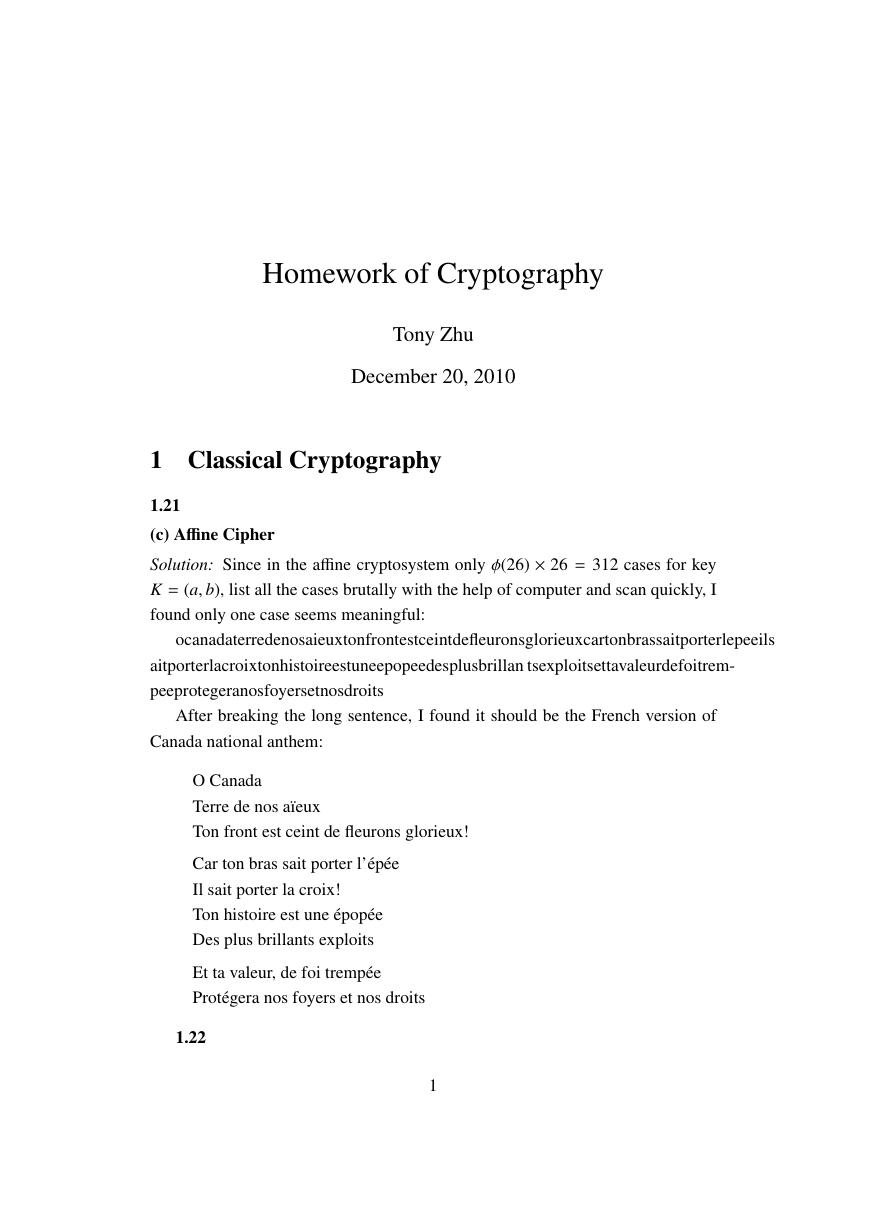
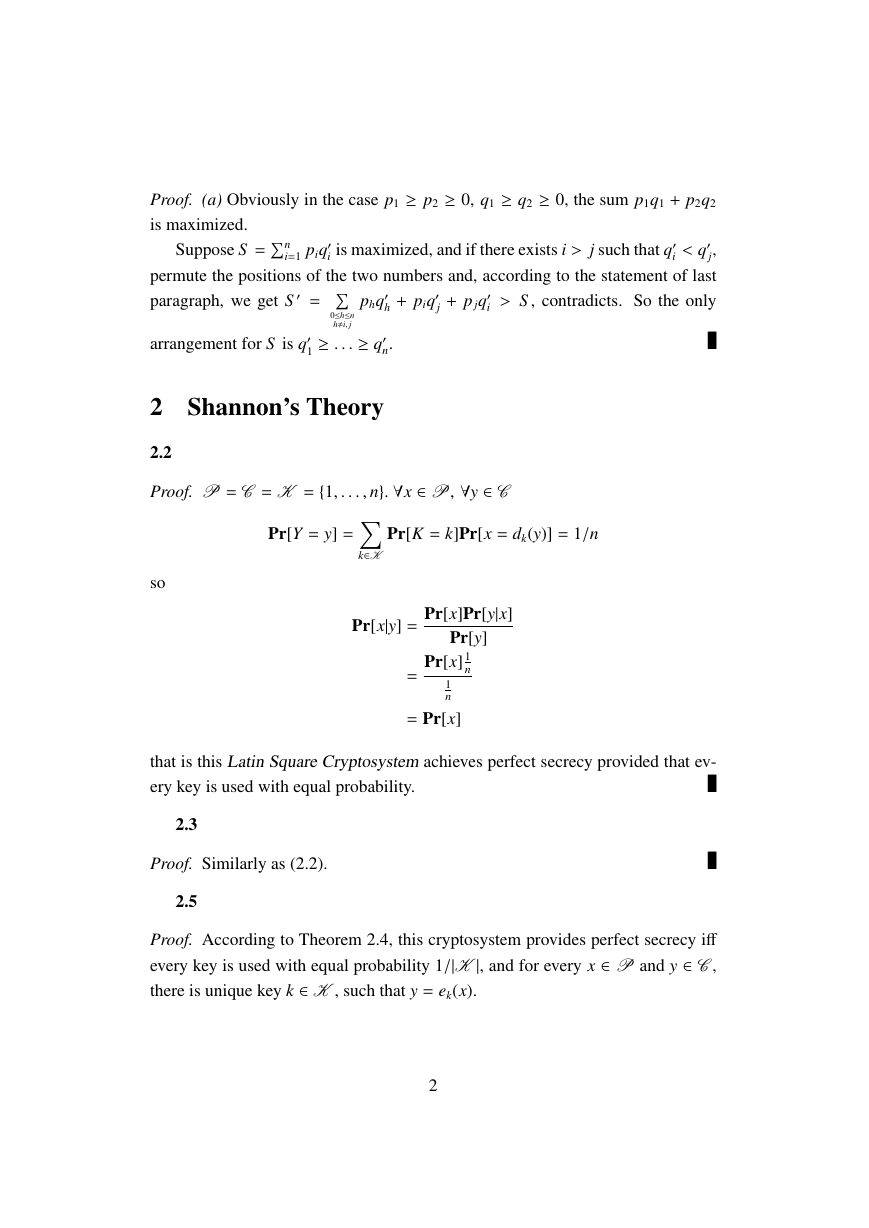
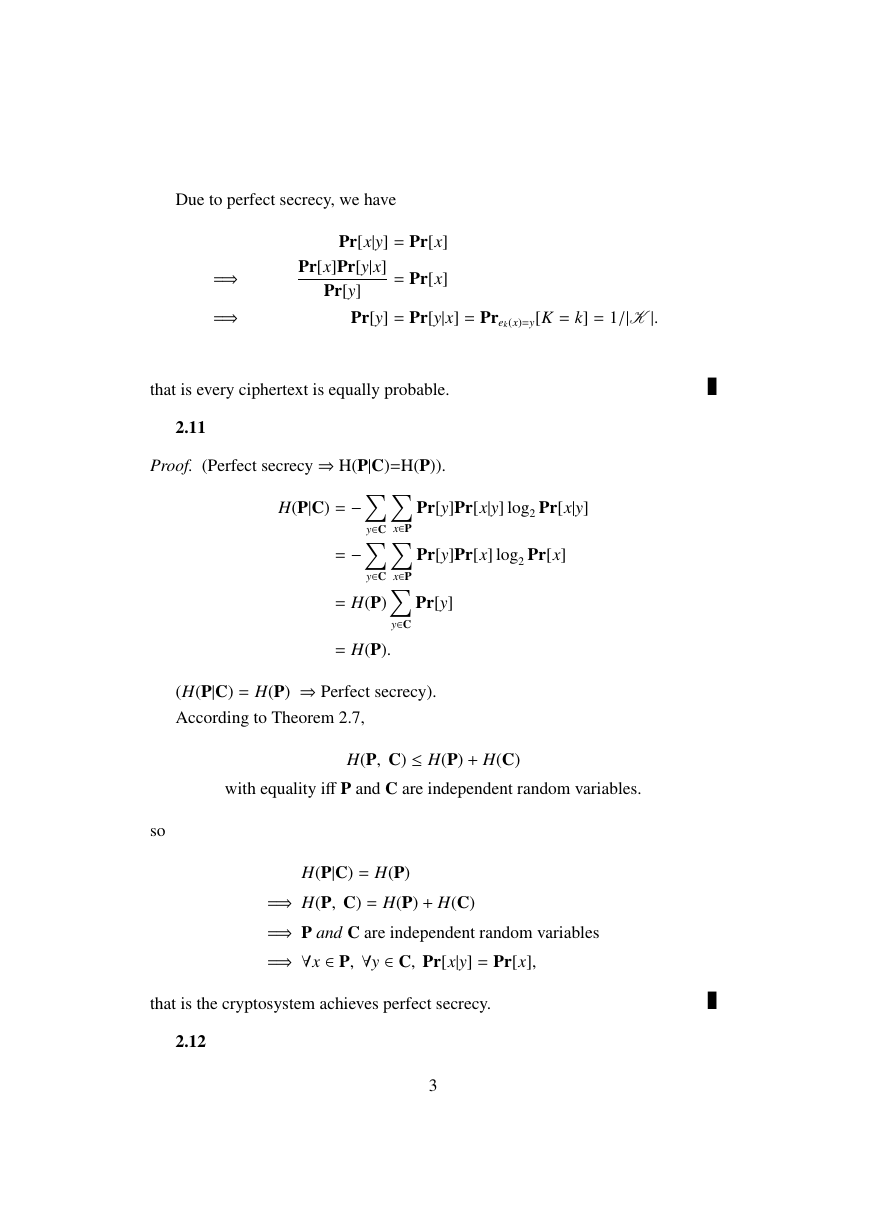
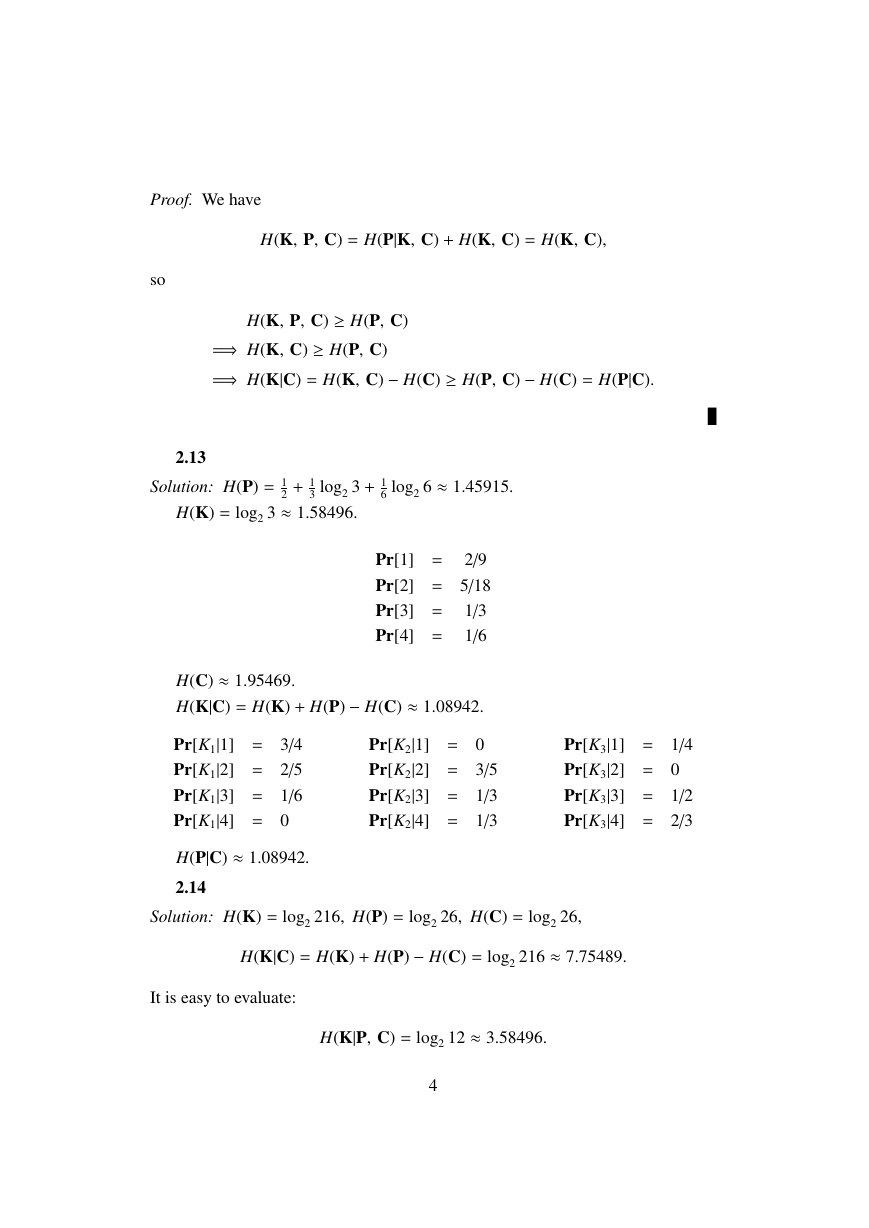
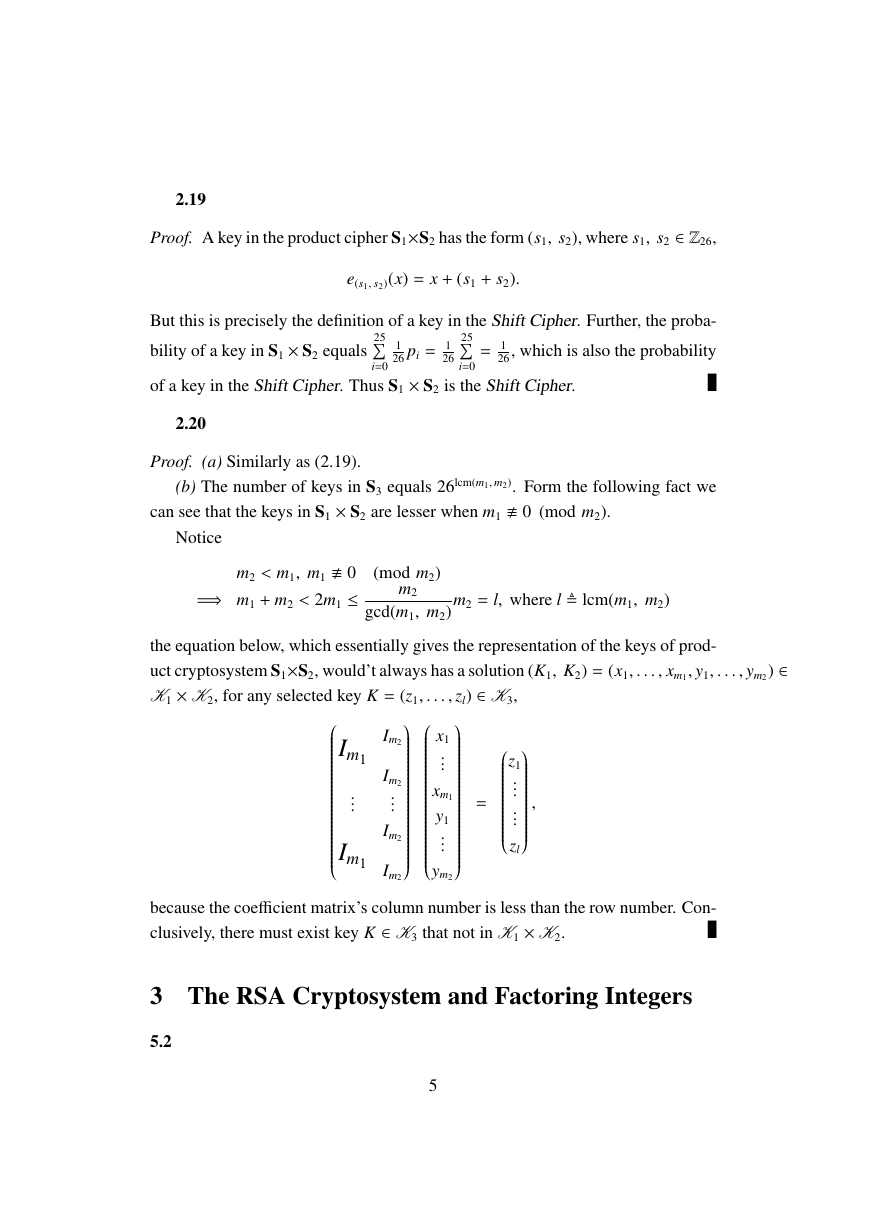

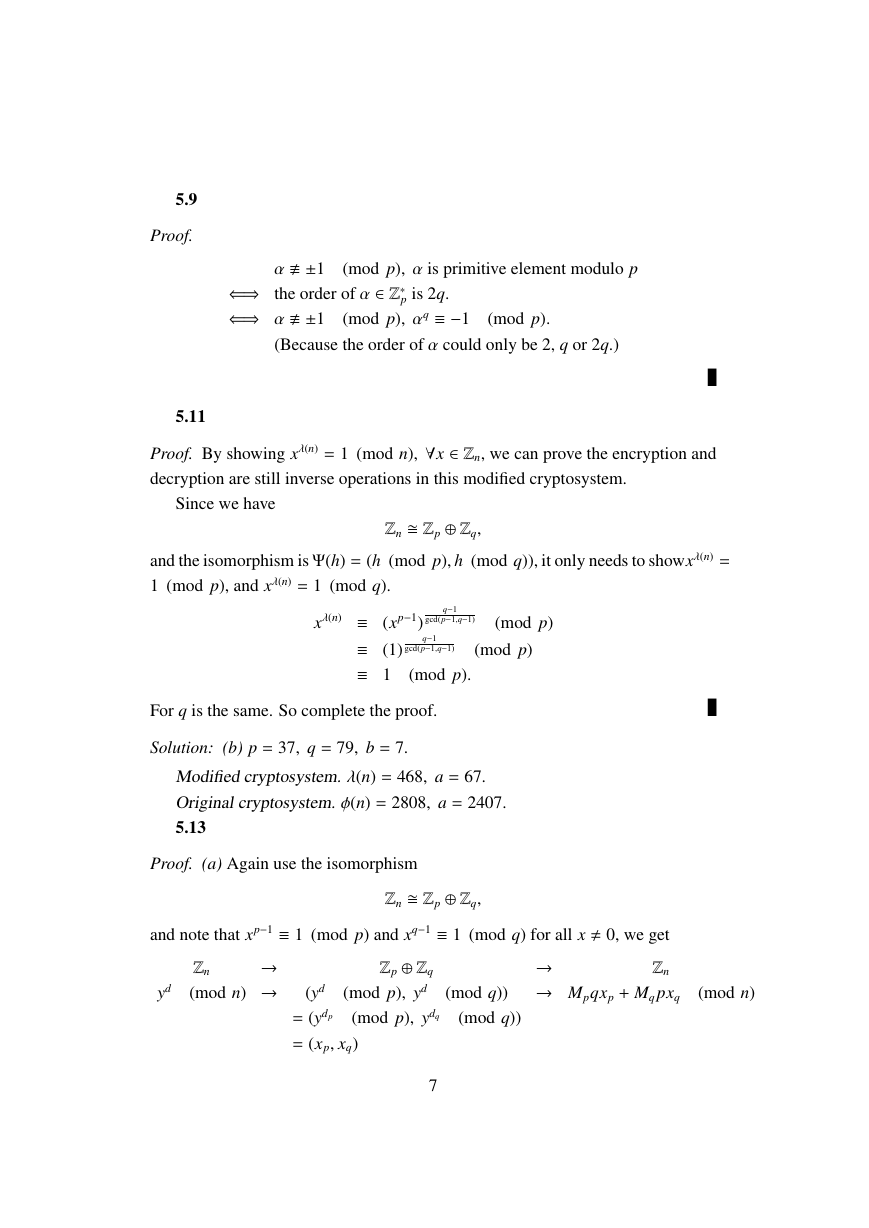
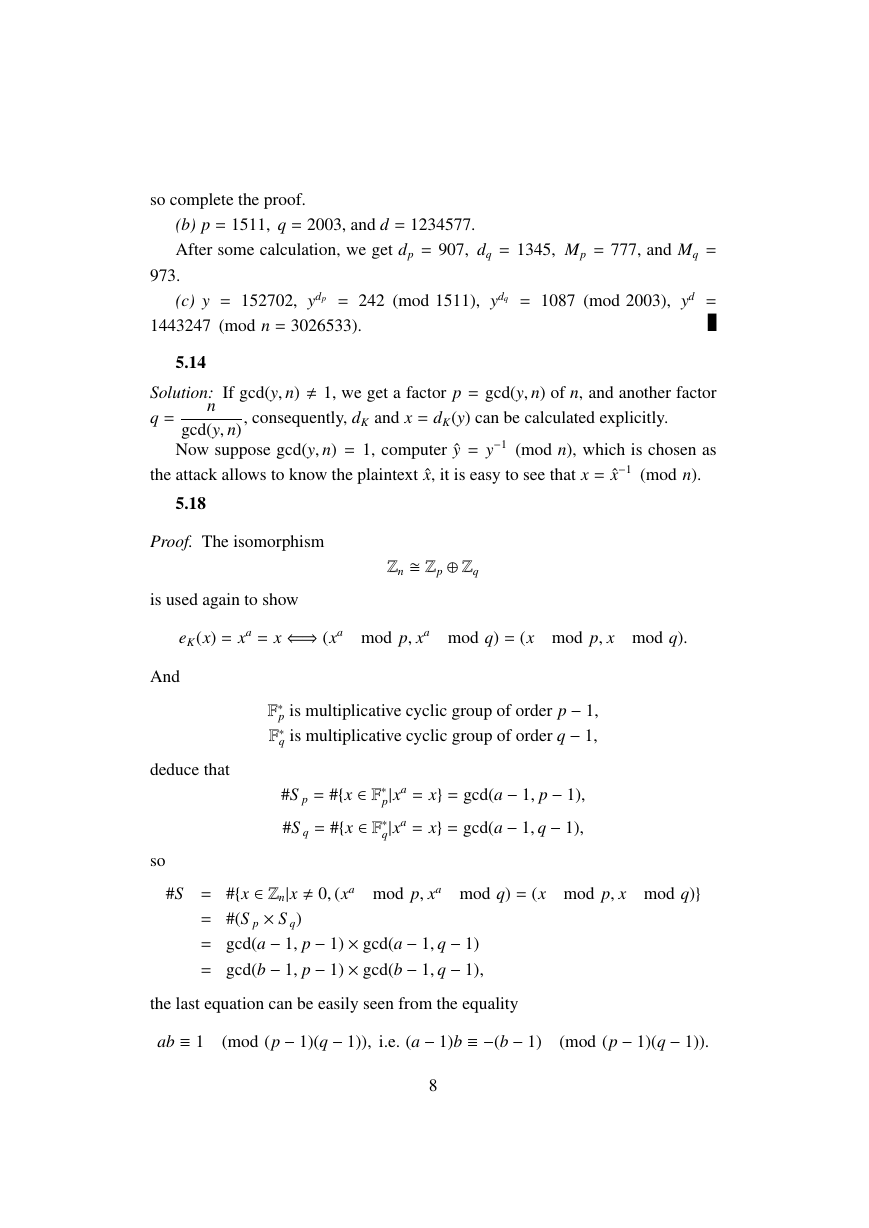








 2023年江西萍乡中考道德与法治真题及答案.doc
2023年江西萍乡中考道德与法治真题及答案.doc 2012年重庆南川中考生物真题及答案.doc
2012年重庆南川中考生物真题及答案.doc 2013年江西师范大学地理学综合及文艺理论基础考研真题.doc
2013年江西师范大学地理学综合及文艺理论基础考研真题.doc 2020年四川甘孜小升初语文真题及答案I卷.doc
2020年四川甘孜小升初语文真题及答案I卷.doc 2020年注册岩土工程师专业基础考试真题及答案.doc
2020年注册岩土工程师专业基础考试真题及答案.doc 2023-2024学年福建省厦门市九年级上学期数学月考试题及答案.doc
2023-2024学年福建省厦门市九年级上学期数学月考试题及答案.doc 2021-2022学年辽宁省沈阳市大东区九年级上学期语文期末试题及答案.doc
2021-2022学年辽宁省沈阳市大东区九年级上学期语文期末试题及答案.doc 2022-2023学年北京东城区初三第一学期物理期末试卷及答案.doc
2022-2023学年北京东城区初三第一学期物理期末试卷及答案.doc 2018上半年江西教师资格初中地理学科知识与教学能力真题及答案.doc
2018上半年江西教师资格初中地理学科知识与教学能力真题及答案.doc 2012年河北国家公务员申论考试真题及答案-省级.doc
2012年河北国家公务员申论考试真题及答案-省级.doc 2020-2021学年江苏省扬州市江都区邵樊片九年级上学期数学第一次质量检测试题及答案.doc
2020-2021学年江苏省扬州市江都区邵樊片九年级上学期数学第一次质量检测试题及答案.doc 2022下半年黑龙江教师资格证中学综合素质真题及答案.doc
2022下半年黑龙江教师资格证中学综合素质真题及答案.doc